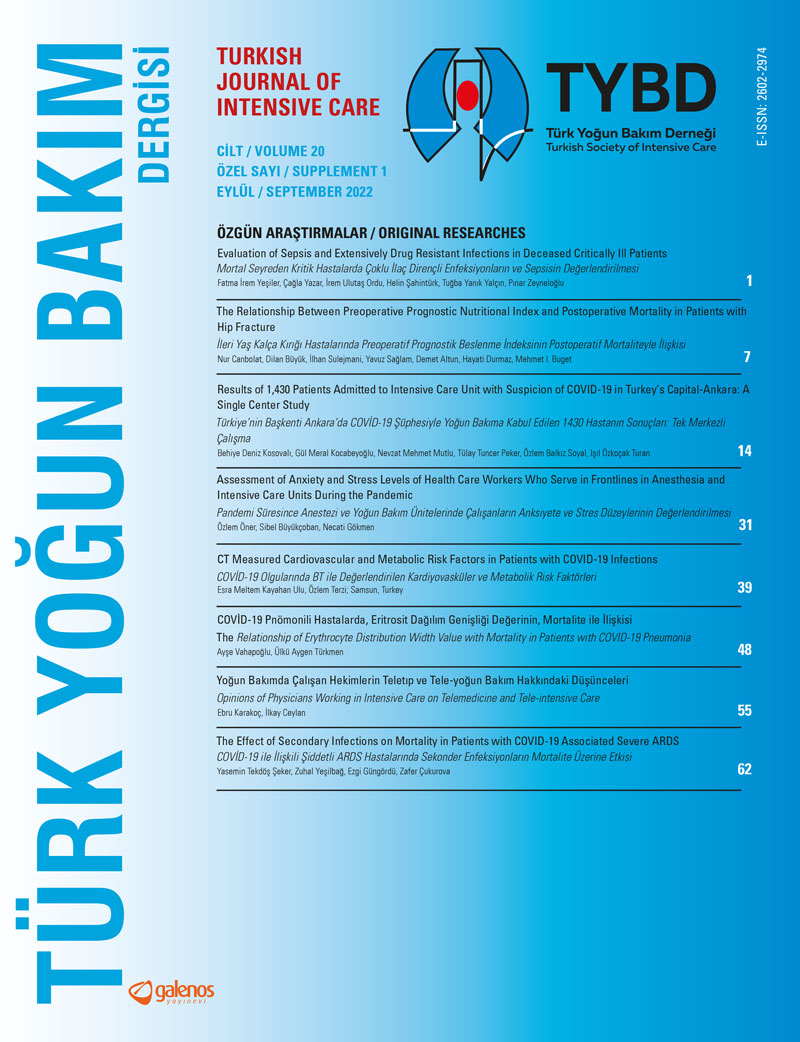Abstract
Objective:
In many studies on patients with acute respiratory distress syndrome (ARDS) caused by severe acute respiratory syndrome coronavirus-2, the mortality rate was found to be high in intubated patients. The aim of this study was to try to understand how intubation affects mortality in patients with coronavirus disease (COVID) polymerase chain reaction-positive ARDS and to understand the relationship between intubation and mortality in the patient group whose PaO2/FiO2 is 100-150 mmHg (moderate) and who have difficulty in intubation decision.
Materials and Methods:
Patient information was obtained by retrospectively examining the hospital computer database and patient files. Three hundred thirteen patients were included in the study. The patients were divided into two groups as intubated and non-intubated according to their intubation status after the first 24 h of their admission to the intensive care unit (ICU) and their intubation status when PaO2/FiO2 was 100-150 mmHg (moderate ARDS).
Results:
In the group of patients who were intubated after the first 24 h, the number of mechanical ventilator days was 9.15±8.58 (p<0.001), the length of stay (LOS) in the ICU was 14.15±10.33 (p<0.001), and the length of hospital stay was 18.33±12.13 (p<0.05), it was longer and statistically significant compared to the non-intubated group. Additionally, 140 (80.92%) of these patients died (p<0.001). The number of mechanical ventilator days was 8.87±8.51 and the LOS days were 13.53±9.6 in the intubated group with moderate ARDS, which was longer and statistically significant than the non-intubated group (p<0.001). Moreover, in 80 (68.4%) of all intubated patients, 60 (37.5%) of the intubated patients with moderate ARDS had secondary bacterial infection (p<0.001) and mortality rates were higher (p<0.001).
Conclusion:
All intubated patients with coronavirus disease-2019, including those with moderate ARDS, had a higher rate of secondary bacterial infection, as well as a higher mortality rate.
Keywords: Acute respiratory distress syndrome, coronavirus, intubation, secondary bacterial infection
References
- Chang D, Xu H, Rebaza A, Sharma L, Dela Cruz CS. Protecting health-care workers from subclinical coronavirus infection. Lancet Respir Med 2020;8:e13.
- Tran K, Cimon K, Severn M, Pessoa-Silva CL, Conly J. Aerosol generating procedures and risk of transmission of acute respiratory infections to healthcare workers: a systematic review. PLoS One 2012;7:e35797.
- Cheung JC, Ho LT, Cheng JV, Cham EYK, Lam KN. Staff safety during emergency airway management for COVID-19 in Hong Kong. Lancet Respir Med 2020;8:e19.
- Laghi F, Tobin MJ. Indications for mechanical ventilation. In: Tobin MJ, editor. Principles and practice of mechanical ventilation, 3rd ed. New York: McGraw-Hill, Inc; 2013. pp. 129-62.
- Wang Y, Lu X, Li Y, Chen H, Chen T, Su N, et al. Clinical Course and Outcomes of 344 Intensive Care Patients with COVID-19. Am J Respir Crit Care Med 2020;201:1430-4.
- Grasselli G, Zangrillo A, Zanella A, Antonelli M, Cabrini L, Castelli A, et al. Baseline Characteristics and Outcomes of 1591 Patients Infected With SARS-CoV-2 Admitted to ICUs of the Lombardy Region, Italy. JAMA 2020;323:1574-81.
- ICNARC: ICNARC report on COVID-19 in critical care 17 April 2020. www.icnarc.org (last accessed on 29 June 2020).
- Richardson S, Hirsch JS, Narasimhan M, Crawford JM, McGinn T, Davidson KW, et al. Presenting Characteristics, Comorbidities, and Outcomes Among 5700 Patients Hospitalized With COVID-19 in the New York City Area. JAMA 2020;323:2052-9.
- Kluge S, Janssens U, Welte T, Weber-Carstens S, Schälte G, Salzberger B, et al. Empfehlungen zur intensivmedizinischen Therapie von Patienten mit COVID-19 – 3. Version: S1-Leitlinie [German recommendations for treatment of critically ill patients with COVID-19-version 3]. Pneumologe (Berl) 2020;17:406-25.
- Tobin MJ. Basing Respiratory Management of COVID-19 on Physiological Principles. Am J Respir Crit Care Med 2020;201:1319-20.
- Tobin MJ, Gardner WN: Monitoring of the control of ventilation. In: Tobin MJ (ed). Principles and practice of intensive care monitoring. McGraw-Hill, Inc. New York: 1998. p. 415-64.
- Pfeifer M, Ewig S, Voshaar T, Randerath W, Bauer T, Geiseler J, et al. Positionspapier zur praktischen Umsetzung der apparativen Differenzialtherapie der akuten respiratorischen Insuffizienz bei COVID-19 [Position Paper for the State of the Art Application of Respiratory Support in Patients with COVID-19 - German Respiratory Society]. Pneumologie 2020;74:337-57.
- Westhoff M, Schönhofer B, Neumann P, Bickenbach J, Barchfeld T, Becker H, et al. S3 Leitlinien: Nicht- invasive Beatmung als Therapie der akuten respiratorischen Insuffizienz. Pneumologie 2015;69:719-56.
- Fichtner F, Moerer O, Laudi S, Weber-Carstens S, Nothacker M, Kaisers U: Clinical practice guideline: mechanical ventilation and extracorporeal membrane oxygenation in acute respiratory in- sufficiency. Dtsch Arztebl Int 2018;115:840-7.
- Zheng R, Hu M, Li R. Respiratory treatment procedures in patients with severe novel coronavirus infected pneumonia: an expert opinion. Chin J Crit Care Intensive Care Med 2020.
- Chittock DR, Ronco JJ, Russell JA. Oxygen transport and oxygen consumption Tobin MJ. Principles and practice of intensive care monitoring New York: McGraw-Hill, Inc;1998. p. 317-43.
- Ronco JJ, Fenwick JC, Tweeddale MG, Wiggs BR, Phang PT, Cooper DJ, et al. Identification of the critical oxygen delivery for anaerobic metabolism in critically ill septic and nonseptic humans. JAMA 1993;270:1724-30.
- Henderson WR, Chen L, Amato MBP, Brochard LJ. Fifty Years of Research in ARDS. Respiratory Mechanics in Acute Respiratory Distress Syndrome. Am J Respir Crit Care Med 2017;196:822-33.
- Tobin MJ. Mechanical ventilation. N Engl J Med 1994;330:1056-61.
- Tobin MJ. Advances in mechanical ventilation. N Engl J Med 2001;344:1986-96.
Copyright and license
Copyright © 2022 The Author(s). This is an open access article distributed under the Creative Commons Attribution License (CC BY), which permits unrestricted use, distribution, and reproduction in any medium or format, provided the original work is properly cited.






















